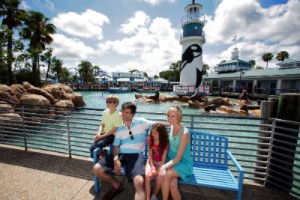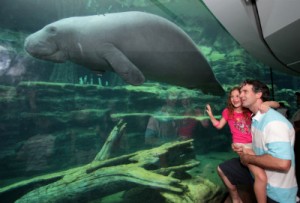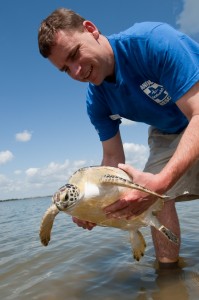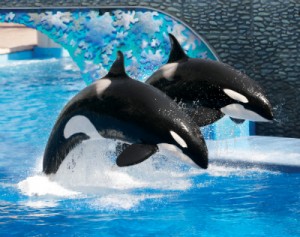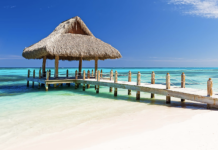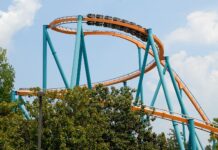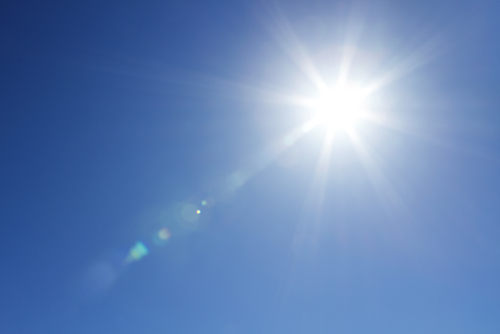Every day of the year, SeaWorld in San Diego and Orlando, USA opens their doors to entertain, amaze and educate guests. Behind the scenes, there also is a mission to care for the environment and the animals beyond our park’s borders.
Pole to Pole: Environmental Awareness
SeaWorld’s Pole to Pole is more than just a gift shop. It provides a variety of kid-friendly activities, including educational crafts, to create awareness of environmental issues aside from offering a variety of winter-themed merchandise. SeaWorld’s popular Pole to Pole Fun Run took place in April 20, 2013 and raised important funds for Hubbs-SeaWorld Research Institute (HSWRI) to help animals in need and endangered species.
Recycling Efforts
From hosting electronic recycling events to green construction, SeaWorld San Diego continues to embrace initiatives that address some of today’s most pressing environmental challenges in the areas of waste, water and food.
Every year SeaWorld® recycles millions of paper and plastic products, metals, greenery, pallets, cooking oil, construction demolition debris and batteries, in addition to more traditional recyclable materials. Since 1996 the park has received San Diego’s Recycler of the Year or Director’s award 15 times and is a 12-time recipient of the prestigious State of California Waste Reduction Awards program.
Since 2007 SeaWorld played host to nine electronic recycling events for California residents. These free collection events offer an opportunity for the public to dispose of unwanted electronic items — such as TVs, VCRs and computers — while making a positive difference in the environment at the same time. More than 325,000 pounds of materials have been collected to date. These events also have raised more than $35,000 for conservation efforts, both local and globally, including habitat preservation, conservation education and aid for ill, orphaned, injured or stranded animals.
To help encourage greater recycling on the part of guests and employees, SeaWorld has more than 300 recycling bins in the park and nearly 50 bins in the staff administration areas.
H20: Reusing a Natural Resource
Innovative moisture sensing technology conserves water by factoring in plant material type, sun exposure, rainfall, and seasonal adjustments when watering. In a variety of areas throughout the park, Xeriscaping is employed, a technique using drought-resistant plants that require little or no irrigation, such as cactus, agave and junipers.
SeaWorld® San Diego voluntarily implements programs recognised by the Environmental Protection Agency as the most acceptable management techniques for handling storm-water runoff and other environmental issues.
SeaWorld San Diego is located on Mission Bay and uses water from the bay for the park’s many pools and habitats. Demonstrating its commitment to environmental stewardship, SeaWorld treats the water before it is returned to Mission Bay. The seawater is filtered and put back in the bay cleaner than it was before. Even the rainwater and water that is used to clean the pathways is collected and cleaned before it is put in to the bay.
SeaWorld San Diego continues to explore other ways of reducing water consumption.
Green Education
SeaWorld’s Environmental Team is made up of employees from various departments throughout the park, including zoological operations, landscape, merchandise, park operations and culinary operations. The team coordinates events in the park that help educate employees on environmental issues and provides them with information on how to conduct themselves, both in the park and at home, in an environmentally friendly manner. The park also provides opportunities for employees to volunteer for activities like beach clean-ups, habitat restoration and e-recycling events.
Culinary Operations: Shamu and Friends Enjoy ‘Green’ Food Choices All of the seafood served to SeaWorld guests — and even the salmon fed to Shamu® — is purchased from sustainably managed fisheries that promote environmentally responsible stewardship.
SeaWorld® works with the Marine Stewardship Council and Aquaculture Certification Council in sourcing sustainable seafood. Both are international, non-profit organisations that promote environmentally responsible fishing, fish farms, processing and food safety.
SeaWorld San Diego also maintains nutritious diets of the park’s animals, while being mindful of effective re-use practices at the same time. For example, we feed beef-baron bones to the polar bears at Wild Arctic, and bread, fruits and lettuces to the domestic animals at Pets Rule!® All these materials are recycled from our culinary operations.
Bye, Bye Plastic Bags!
Back in June 2011 SeaWorld® San Diego became the first SeaWorld park to phase out plastic bags at gift shops. The effort coincided with the grand opening of Turtle Reef. Plastic bags are a huge problem for certain species of sea turtles, especially leatherbacks, which sometimes mistake the bags for jellyfish. Turtle Reef, where guests have the opportunity to get an up-close look at up to 60 sea turtles and learn about the threats the species face, demonstrates this devastating impact.
“We’re proud of SeaWorld San Diego as they continue to demonstrate their leadership role in environmental stewardship by eliminating plastic bags in their park,” said John Valencia, executive director of the San Diego Oceans Foundation. “Hundreds of thousands of sea turtles, whales and other marine animals die every year from ocean pollution by ingestion or entanglement of marine debris.”
“SeaWorld is proud to be a responsible steward of the environment, not just here in our park, but in the oceans and the world we share,” says SeaWorld San Diego Park President John Reilly. “We hope our actions will inspire others to take similar steps that, combined, can make a huge difference.”
Animal Rescue and Rehabilitation Program
Since 1965, SeaWorld® San Diego has rescued more than 6,500 animals and has treated as many as 475 marine mammals in one year. Of these animals, seals and sea lions form the largest share. Birds, such as pelicans, also are frequently rescued. Last year, SeaWorld rescued 131 marine mammals: 98 California sea lions, 18 northern elephant seals, eight harbour seals, four common dolphins, a fur seal, a Guadalupe fur seal and a southern sea otter. In addition, SeaWorld took in 451 birds (276 of which were brown pelicans) and four sea turtles for rehabilitation.
SeaWorld is part of the Southwest Marine Mammal Stranding Network, which is organised by the National Marine Fisheries Service (NMFS). Members of the public, lifeguards and other individuals report strandings to SeaWorld’s rescue hotline (800-541-SEAL) and SeaWorld team members respond, using guidelines governed by NMFS. Once rescued, animals are nursed back to health and, whenever possible, returned to the wild. If an animal is deemed not releasable, NMFS determines whether the animal is to remain at SeaWorld or to be cared for at another facility.
Marine mammals such as seals, sea lions, sea otters, dolphins, whales, sea turtles and seabirds may strand for a variety of reasons: illness, injury, exhaustion or separation from their mother. Two of the most common conditions are malnutrition and dehydration. In addition, animals may also become entangled in nets, ropes or fishing line; accidentally ingest plastic or other foreign objects; or suffer habitat loss, which occurs as a result of human development, over harvesting of natural resources or oil spills.
To care for stranded animals, SeaWorld San Diego is equipped with a state-of-the-art medical facility, which houses a laboratory with the latest diagnostic equipment, antibiotics, intravenous fluids and other medications; a surgical suite, which contains a custom surgery table, X-ray, ultrasound, endoscopy and anesthesia equipment; a food preparation room, where special diets for rehabilitated animals are prepared; and recovery areas, including pools and enclosures, tailored to meet the specific needs of each rehabilitating animal.
Oiled Wildlife Care Centre
SeaWorld® San Diego’s Oiled Wildlife Care Center was built to care for animals that fall victim to oil spills.
The 8,000-square-foot center was established in 2000 by SeaWorld San Diego, the California Department of Fish and Game and the University of California, Davis. It includes examination, treatment and food preparation areas, an aviary and a 32,000-gallon rehabilitation pool that can hold 20 oiled sea otters or pinnipeds in the event of an oil spill in Southern California. The facility can treat as many as 200 oiled seabirds at a time. The centre is one of five regional oiled wildlife rescue and rehabilitation facilities participating in the Oiled Wildlife Care Network.
The centre is staffed by team members from SeaWorld San Diego’s aviculture and animal care departments who have received state certification and training to work with oiled animals. When the centre is not being used for oil spill rescue, it houses rehabilitating marine mammals, sea turtles and seabirds.
Happy Tails
SeaWorld® is continuing a program established in April 2011 to reach out to some furry, four-legged creatures at the Helen Woodward Animal Center to encourage adoptions of homeless dogs and cats. “SeaWorld’s Happy Tails” animal adoption program provides pet lovers two free single-day admissions to SeaWorld when they adopt a dog or cat from the Helen Woodward Animal Center. The program has been extended and will continue through Dec. 31, 2013. Tickets are valid for a single-day admission to the park any time within one year of the adoption.
SeaWorld has supported local animal shelters by providing homes, and a second chance at life, for hundreds of abandoned and neglected animals. Considered by many untrainable, these adopted animals now steal the stage — and fans’ hearts — as stars in the park’s popular show Pets Rule!® Promoting the importance of shelter adoptions, these furry ambassadors bring smiles to thousands of guests every day.
Education and Conservation
The education programs at SeaWorld® and Busch Gardens® have helped schools, teachers, children and adults explore the world and all its inhabitants by providing award-winning education programs that include structured teaching. There also are many informal teaching experiences inside the parks: educators, show and exhibit narrations, and interpretive and interactive graphics. SeaWorld’s Instructional Field Trip program offers students from pre-school through college an opportunity to use the parks as their own outdoor classroom.
In 2012 SeaWorld’s Education and Conservation Department educated millions of park guests through live narration and interpretive material at the park’s animal habitats and more than 40,000 people participated in behind-the-scenes guided tours. SeaWorld was brought to hundreds of students through SeaWorld Cares® school assemblies in Southern California, Arizona, Nevada, Colorado and Utah. The park also became an outdoor classroom to more than 92,000 school children visiting SeaWorld for Instructional Field Trips and In-depth tours.
Shamu TV
“Shamu TV”, the Emmy award-winning environmental education series from SeaWorld® and Busch Gardens®, brings viewers face to face with the wonders of wildlife. Online viewers have the opportunity to watch an entire 30-minute episode or shorter, five- to 10-minute segments featuring stories about amazing animals and the remarkable efforts of people working together to save some of the world’s most endangered and threatened species.
“Shamu TV” is accessible in school classrooms via computer, and on-the-go through tablet and hand-held devices via ShamuTV.com and YouTube. A “Teacher Toolbox” full of activities, reference materials and resources to enhance lesson planning will soon be made available for teachers. “Shamu TV’s” Saving a Species series is produced by the SeaWorld/Busch Gardens Education Departments.
© SeaWorld Parks & Entertainment. All Rights Reserved

